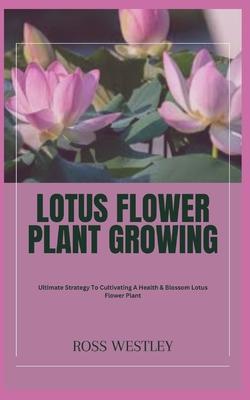
Book
Lotus Flower Plant Growing: Ultimate Strategy To Cultivating A Health & Blossom Lotus Flower Plant
by Ross Westley
(Write a Review)
Paperback
$8.99
The lotus flower is endemic to Asia, specifically the subcontinents of India, China, and Japan. It does best in ponds, lakes, and slow-moving rivers with a shallow water depth. This perennial plant floats on the water's surface with its large, spherical leaves, and its beautiful flowers rise above the leaves on tall stalks.
The lotus flower's ability to flourish despite its origin in dirty water is one of its most alluring features. Because of this, the lotus has come to symbolize enlightenment, spiritual awakening, and purity in a wide variety of civilizations around the world. The lotus is a potent symbol of triumph over adversity and openness to development.
Lotus flowers are renowned for their stunning beauty and are available in a rainbow of colors. The layers of petals on the blooms are often rather elaborate, making for a stunning appearance. They attract many species of pollinators, including bees and butterflies, because to the enticing scent they give out.
The lotus flower is revered for more than just its beauty and symbolism; it also has significant therapeutic value. All components of the lotus plant, from seeds to leaves to rhizomes, are put to use in ancient medical practices including Ayurveda and ancient Chinese Medicine. Diseases of the digestive system, the respiratory system, and the mind are all included.
The lotus plant is significant for the environment in addition to its cultural and therapeutic value. Its large leaves cast a protective canopy over the water, lowering the temperature and preventing algal blooms by blocking the sun. The plant also provides food and shelter for many different kinds of aquatic life, which helps maintain ecological harmony.
In sum, the lotus flower plant is a fascinating and versatile species thanks to its spiritual meaning, aesthetic value, and therapeutic uses. It is a fascinating and treasured botanical marvel because of its existence in many civilizations and its resilience in the face of adversity.
The lotus flower is endemic to Asia, specifically the subcontinents of India, China, and Japan. It does best in ponds, lakes, and slow-moving rivers with a shallow water depth. This perennial plant floats on the water's surface with its large, spherical leaves, and its beautiful flowers rise above the leaves on tall stalks.
The lotus flower's ability to flourish despite its origin in dirty water is one of its most alluring features. Because of this, the lotus has come to symbolize enlightenment, spiritual awakening, and purity in a wide variety of civilizations around the world. The lotus is a potent symbol of triumph over adversity and openness to development.
Lotus flowers are renowned for their stunning beauty and are available in a rainbow of colors. The layers of petals on the blooms are often rather elaborate, making for a stunning appearance. They attract many species of pollinators, including bees and butterflies, because to the enticing scent they give out.
The lotus flower is revered for more than just its beauty and symbolism; it also has significant therapeutic value. All components of the lotus plant, from seeds to leaves to rhizomes, are put to use in ancient medical practices including Ayurveda and ancient Chinese Medicine. Diseases of the digestive system, the respiratory system, and the mind are all included.
The lotus plant is significant for the environment in addition to its cultural and therapeutic value. Its large leaves cast a protective canopy over the water, lowering the temperature and preventing algal blooms by blocking the sun. The plant also provides food and shelter for many different kinds of aquatic life, which helps maintain ecological harmony.
In sum, the lotus flower plant is a fascinating and versatile species thanks to its spiritual meaning, aesthetic value, and therapeutic uses. It is a fascinating and treasured botanical marvel because of its existence in many civilizations and its resilience in the face of adversity.
Paperback
$8.99